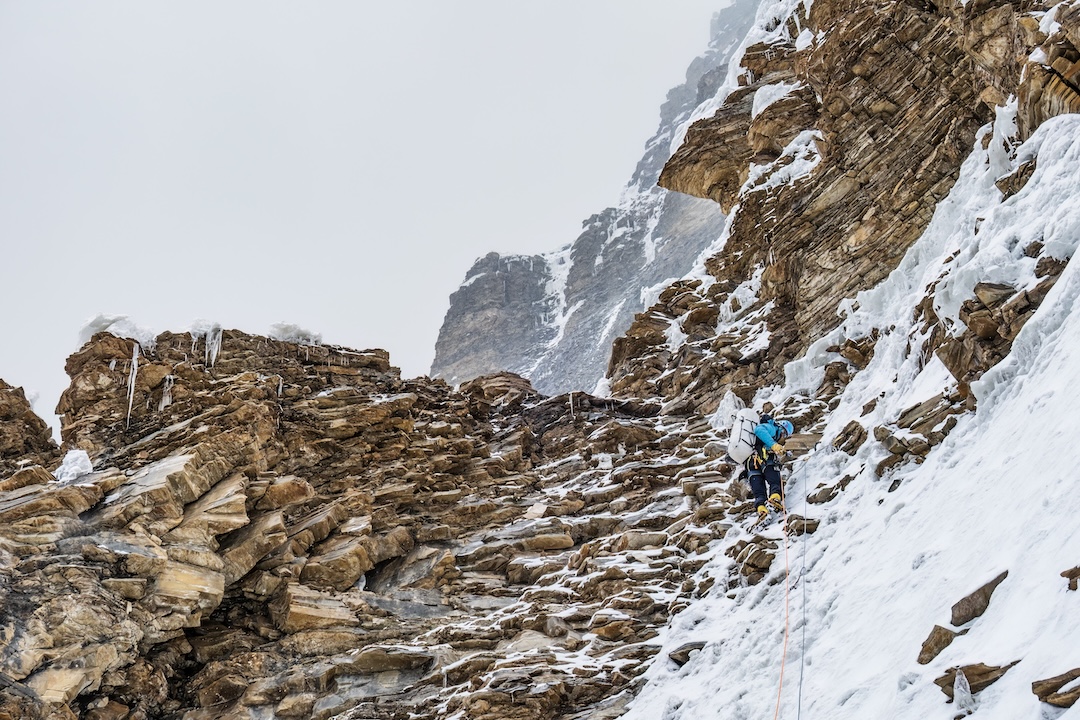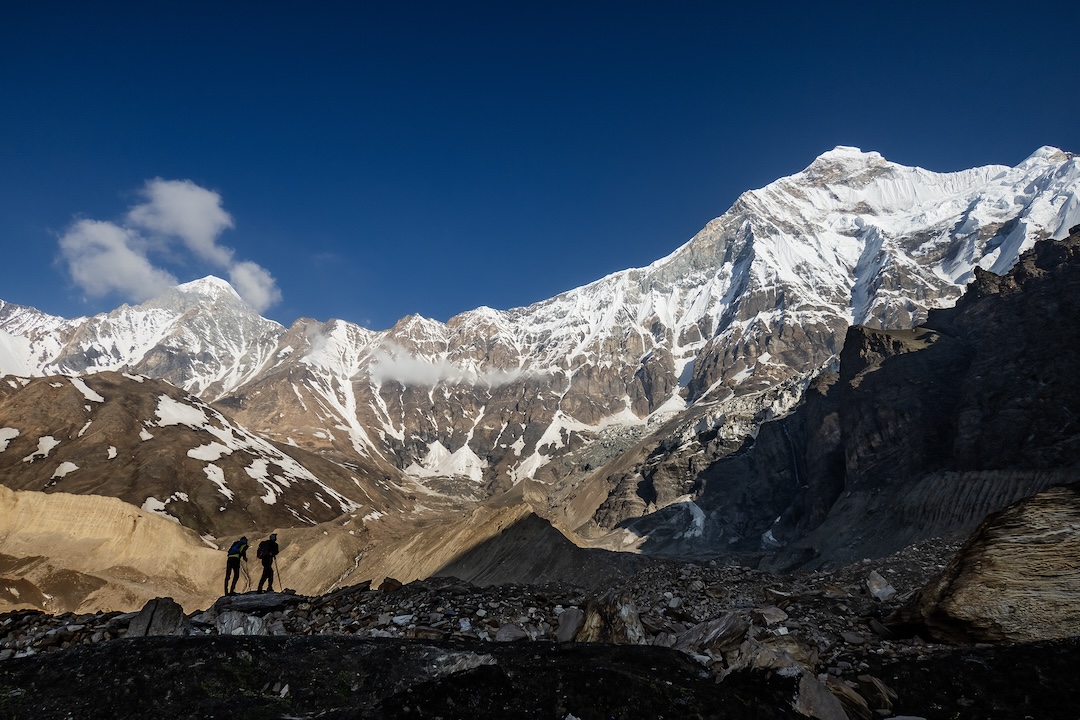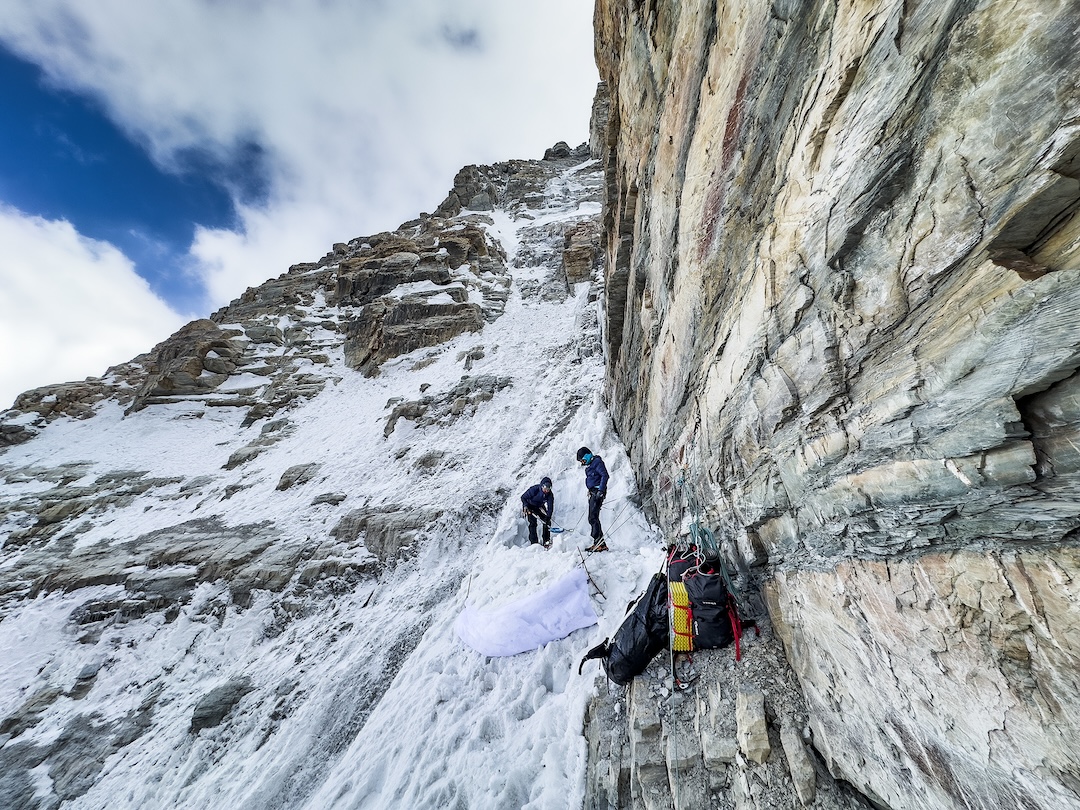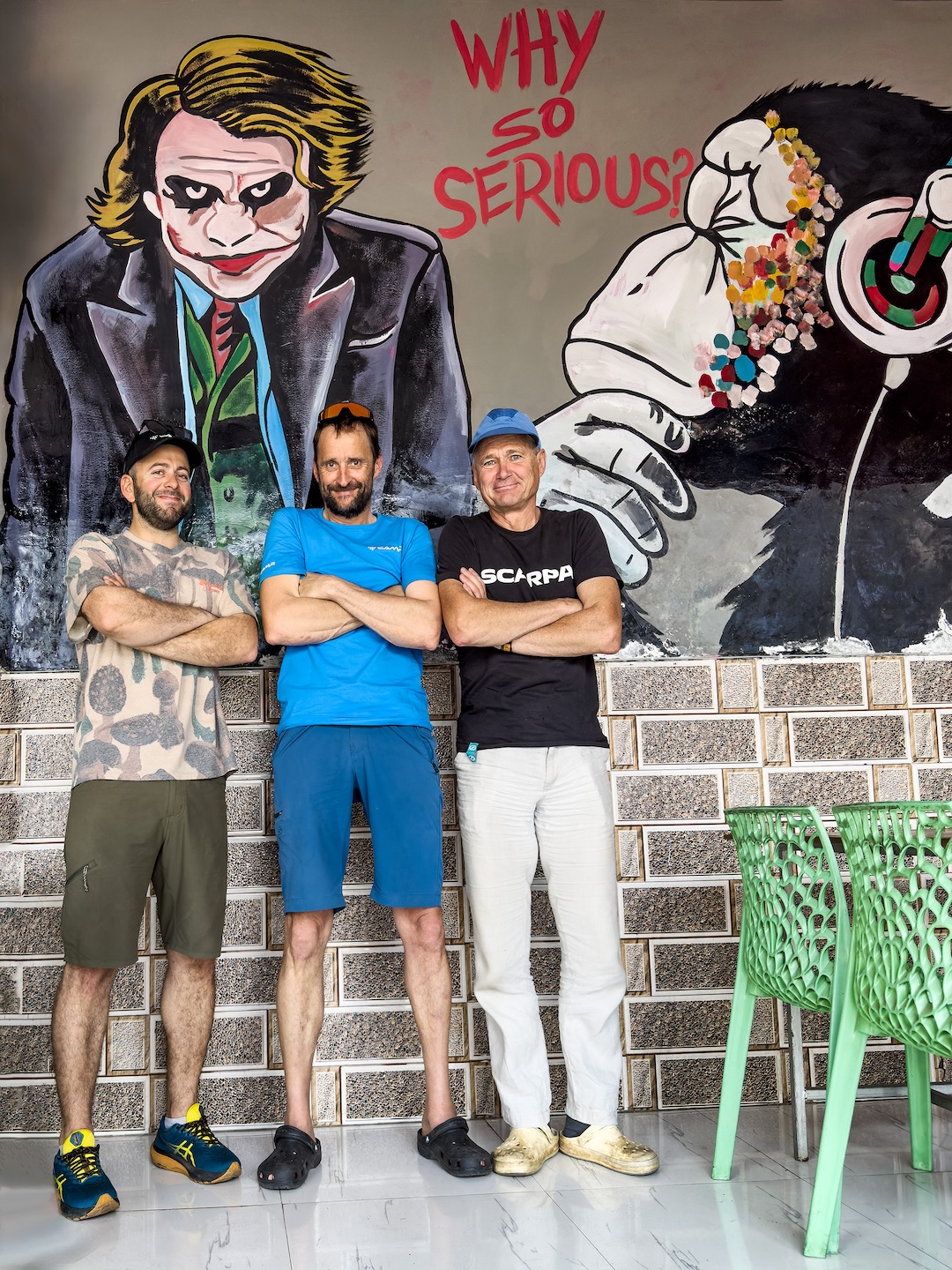Dirty Dancing: New Routes in the Indian Himalaya
India, Eastern Garhwal

This has never been climbed,” Dhruv tells us. A passionate local climber and a living guidebook, Dhruv Joshi helped put our expedition to India together. He points to a beautiful pyramid just to the south of Nanda Devi East: “About 6,300 meters.” Three pairs of skeptical eyes turn toward him. Marko asks, “Are you sure?”
Dhruv nods in the distinctive Indian manner, tilting his head from side to side. “Very sure!” The seed is planted. To hell with gradual acclimatization—this mountain is ours. But first, the scene and the players: The idea had emerged almost a decade ago, following a challenging expedition to Cerro Kishtwar with Hayden Kennedy, Urban Novak, and Marko Prezelj. I had told them about Nanda Devi East, an open peak with beautiful ice lines. Then time passed. Hayden was gone. Our lives filled up with other climbs, other obligations. But this mountain stayed in a corner of my mind.
Two years ago, at an Iranian friend’s wedding, I met Archil Badriashvili, a young Georgian climber who was in France to receive a Piolet d’Or for his bold ascent of Saraghrar Northwest in Pakistan. He wanted to climb in Chamonix, but autumn monsoons had shut everything down. Instead, I took him to some dry-tooling cliffs in Savoie.
A few months later, following a guided trip in Svaneti, Georgia, we met again in Tbilisi. Over drinks—Georgia’s second national sport after alpinism—we talked about mountains and projects, and at some point, Marko’s name and Nanda Devi East came up.
Suddenly, everything clicked. A selfie sent to Slovenia, another round of drinks, and the project was born. The three of us, on a big, beautiful mountain.

May 19, 2024. Nine days after leaving Europe, we arrive at base camp at 4,300 meters in the Lawan Valley. With us is Bhagwan, who helped us in 2015 on Cerro Kishtwar, along with Debrash and Mukesh, our two cooks. The team is complete. A few days later, we are joined by Kushal the shepherd, his 300 sheep, and his two dogs, Bachu and Pinkie—expert salami thieves. A small village forms at the foot of the mountain.
Dhruv stays with us for a few days, passionately recounting his ascents and the history of the region’s peaks. He delivers details—dates, times, altitudes—with an astonishing level of precision. He works for the Indian Mountaineering Foundation (IMF), which issues climbing permits. Our briefing in Delhi had been surreal. Since satellite phones are banned in India, we asked about the emergency protocol in case of an accident. The IMF director’s answer stunned us as much as it amused us: “You make smoke signals!”
After a few days of acclimatization and exploring, we make our final decision: Dhruv’s unclimbed peak will be our first objective. The approach requires a long day of hiking. Bhagwan and Debrash help us carry loads. Bhagwan is like the fourth man on our team—he knows us well. He has the spirit of a mountaineer—sharp, critical. His definition of alpine style is blunt and to the point: “Muscle, mind, and money.”
We establish a bivy at 5,000 meters. The east face rises more than 1,200 meters above us, but we convince ourselves we can push to the top and start the descent in a single day, bivying at Longstaff Col on our way down. Just in case, though, we’ve packed for four days. We climb a 300-meter snow couloir, then veer right toward our chosen line. The first technical pitch makes it clear: The rock quality and technical difficulty will stretch this climb beyond a single day.
By 5 p.m., we reach the base of the ice gully we plan to follow to the top. There’s no way we’ll push through before nightfall. Marko, who has been dragging two-meter-long bamboo poles for two days, finally reveals his plan.
“We will bivy here,” he announces.
Archil and I look at him with a mix of amusement and disbelief. Marko pulls out his magic tarp and fixes the poles to the sides, creating a sort of hammock that we fill with snow. After an hour of shoveling, we have a horizontal platform big enough for our tent.
“I can’t believe this works,” Archil mutters.
“Welcome to Marko’s School of Suffering,” I say.
We don’t know it yet, but this will become our standard technique for the next month—to Marko’s great delight.
Morning comes, and waking up in our ultra-light French-made tent—worth the price of a house in India—is brutal. There’s more ice inside than outside.
“This reminds me of my father’s stories about Soviet alpinism,” Archil mutters, shivering.
The climbing above is harder than expected. Conditions worsen. Water starts running down the rock. The snow slopes we thought would be straightforward feel alarmingly thin.
At 5 p.m., we reach the summit—6,344 meters.
Stepping into the sun, we realize the adventure isn’t over. The ridge down to Longstaff Col has unexpected obstacles. Abalakovs, snow mushrooms, pitons, rappels, downclimbing… Seven hours after leaving the summit, we reach the col. But again, things don’t go as planned. What Marko had optimistically described as a “ski slope” below the col turns out to be a steep, unstable mix of mud and snow. Four hours of pure focus. Nobody speaks. Even Marko doesn’t take out his camera. It takes 12 hours to reach base camp.
The privilege of opening a new route on an untouched 6,344-meter peak sinks in slowly. We celebrate accordingly. After discussing with Bhagwan, we name the mountain Nanda Shori: “Daughter of Nanda.” The route? Dirty Dancing.

On an expedition, time takes on a different rhythm. I appreciate the hyperactivity of a multiday climb just as much as the stillness of so-called rest days. These days are precious—not only for the essential recovery they provide but also for their simple routines: eat, drink, read, talk.
Six days after our ascent of Nanda Shori, we’re setting off again. This time for big mama: the southeast face of Nanda Devi East, also known as Sunanda Devi, 7,434 meters.
But first, the ritual: laying out all our gear on a tarp and debating for hours over whether we really need the number 3 Camalot.
Our planned line is the central pillar on the face: 1,600 meters of climbing, linking up with the normal route on the south ridge, first climbed in 1939, at 6,900 meters.
The approach from base camp takes a full day. After balancing along the moraine like highliners, we leave Bhagwan and Debrash behind; they’ve helped us carry loads, but from here, we’re on our own.
The terrain quickly becomes trickier. The glacier is a mess—loose stones covering black ice. The weight of our packs grinds us down. We plan to bivy at 5,200 meters, just below the icefall we’re intending to climb. But as we approach, the whole thing collapses before our eyes. In a matter of minutes, the weather shifts violently. Snow starts hammering us as we pitch the tent.
The plan has to change.
We decide to attack via a different gully, farther left. The first pitches set the tone: Marko pulls out all the stops, leading through vertical, unprotected walls. We soon realize we’ll have to traverse several gullies and buttresses to link up with our original line. The forecast had called for light snowfall in the afternoon. At 9 a.m., it’s snowing like it’s Christmas.
By midafternoon, the spindrift is growing heavier. Trying to push through steep, rotten snow, I stop to place protection and hear Marko’s irritated voice.
“What are you doing?”
“I’m leading,” I snap.
That ends the discussion.
Archil watches in silence as we two old friends argue and then—the privilege of long-standing friendship—make peace a minute later and move on, laughing.
At 6 p.m., after 16 pitches, I find what looks like a potential bivy ledge. I start digging, using our magic tarp to anchor the site. By 8 p.m., we’re all crammed into our portable freezer. It’s still snowing.
To our great surprise, Archil pulls out half a liter of chacha—homemade Georgian alcohol, one step removed from ethanol. I can’t help but think about the number 3 Camalot we left at base camp because it was “too heavy”—it would have been really useful today. But a few sips of chacha are enough to warm us up and find some dark humor in a day that pushed us to our limits.
Morning brings blue skies but also unseasonably high temperatures. Archil moves into the lead. It takes him two hours to climb the first pitch of steep snow. The next pitch is worse—snow, loose rock, mud. Another two hours.
We reach 5,900 meters. From here, we need to traverse another 200 meters to reach the central buttress. The snow runnels give way to mud, streams, and falling rock.
It’s decision time. If we go farther, retreat will become a nightmare, and none of us is confident we can push to the top in these conditions. We take time to listen to everyone’s thoughts. The final call is unanimous: We go down.
The biggest reason—besides fear—is the conditions are slowing us so much that we’re reaching the limits of the alpine style we love. Style matters.
That day, we learn later, the freezing level rose above 6,000 meters. Delhi hit 51°C. Thousands of kilometers away, in France, dark storm clouds gathered.
Our disappointment seems trivial. We chose to be here. The extreme temperatures we faced will have far greater consequences for people in the world’s growing megacities. For us, it’s just a few rappels and a long march back to base camp to digest our failure and think about our next attempt.
The heat won’t let up, and our plan to return to Nanda Devi East slips away.
We still have time left, though, and we want to make the most of our trip. Across from base camp, two striking peaks and their north faces are calling: Nanda Kot (6,851m) and Changuch (6,322m). We make our way up the moraine leading to both mountains, and soon it’s clear—we’ll go for Changuch. The approach to Nanda Kot looks far more complicated.
Changuch was first climbed in 2009, by the northwest ridge, by a British-Indian expedition led by Martin Moran; they approached from the Lawan Valley to the north, same as us. Two years later, Dhruv led an Indian team that repeated the northwest ridge, reaching it from the south. We choose a couloir that cuts through the northeast face—still unclimbed.
This time, better acclimatized, we go light. We leave base camp early, aiming to gain the pillar bordering the couloir and bivy as high as possible. A few hours into the approach, we reach the base of the face.
Then we see them. A herd of bharal, Himalayan blue sheep—30 of them—moving up the pillar. They’re much faster than us. Instead of veering off, they keep climbing, heading straight up.
By midafternoon, we have set up camp on a ledge at 5,600 meters, at the base of a rocky tower. Focused on carving out a platform, we barely notice the falling stones. We assume it’s the heat. Then the rocks get closer. When we look up, we see the blue sheep, higher up the ridge, scraping at the ledges with their hooves.
Deliberately.
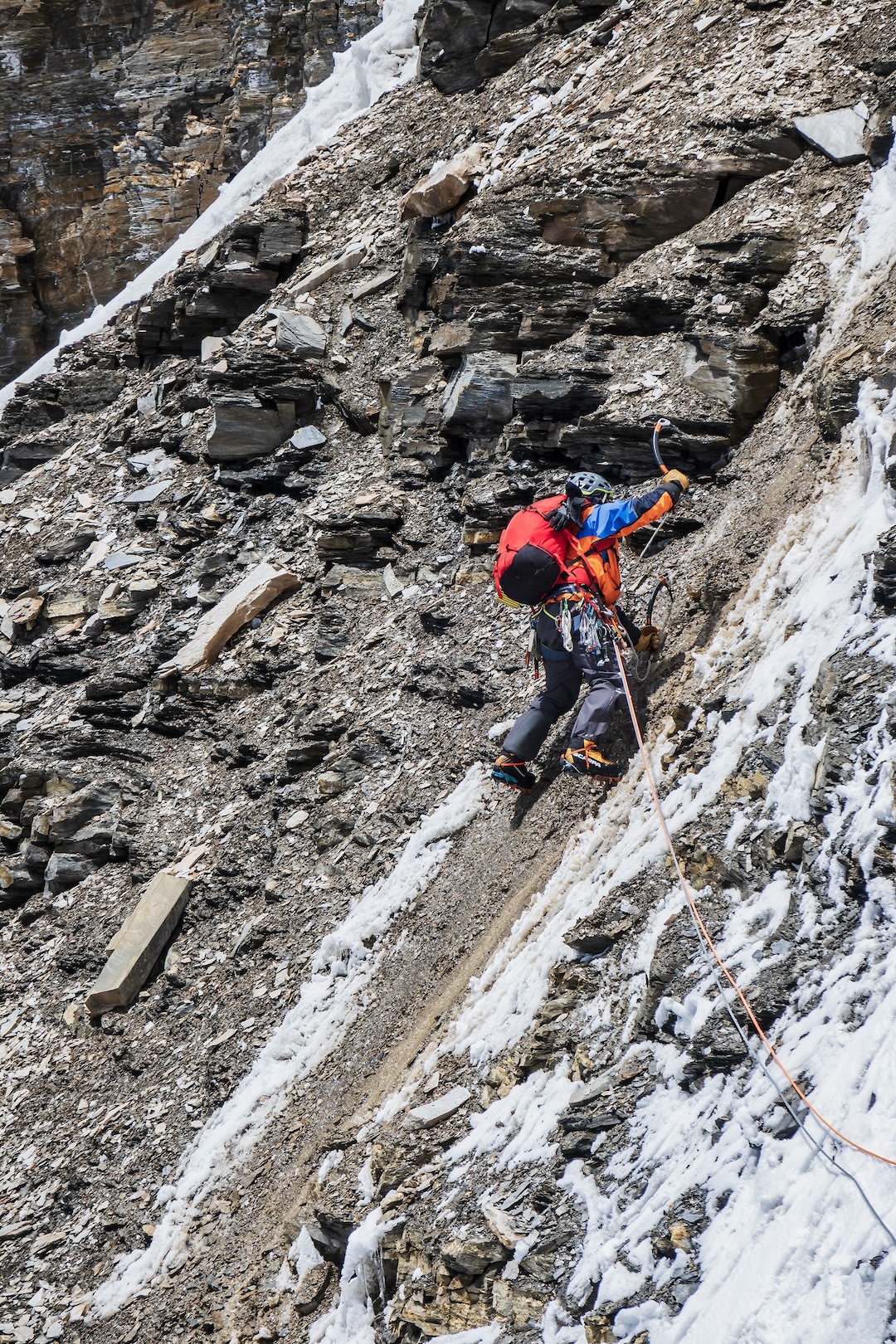
They’ve climbed all the way to the top of the pillar at 6,200 meters. And now, unable to escape onto the other side, they’ve decided the best defense is attack. At first, we find it funny. Then it stops being funny. They’re 30. We’re three. And we’re trespassing on their territory.
Night falls. The bombardment slows, but one particularly bold attacker moves closer. He refines his aim. A stone rips through the tent, landing right between Archil’s leg and my head. On the upside, the tent now has better ventilation.
The rockfall stops for the night, but we sleep with one eye open, helmets on, backpacks as shields. At sunrise, Marko crosses the couloir quietly. But our neighbors spot him immediately. The barrage resumes. Archil and I wait an hour for a lull before making our move. It takes seven hours to reach the summit ridge. Only when we reach their level do the sheep decide to retreat. They descend the pillar in under a minute, without dislodging a single rock.
The stress lifts, but the final 150 meters to the summit present a nasty mix of black ice, corniced ridges, and whiteout.
There’s no summit euphoria. Just the weight of the descent ahead. We’d planned to go light and move fast. Instead, we’re slow, exhausted, dehydrated. Eighteen hours after leaving our small tent, and after a long series of nighttime rappels, we stumble back to our bivy.
Marko collapses inside the tent. Archil and I start melting snow. Then I hear it. Voices. At first, faint. But soon, distinct. English. Hindi.
I freeze. “Archil, do you hear that?”
He looks at me—half amused, half uneasy.
I step outside. The voices grow clearer. Conversations. Whispers. It goes on for over an hour. I know what’s happening. The exhaustion, stress, dehydration, and altitude—it’s creating something between a dream and reality. Eventually, I fall asleep. By morning, the voices are gone. Later, back home, I read Les Hallucinés by Thomas Vennin, a book on high-altitude auditory hallucinations. It’s reassuring.
This expedition was full of surprises. A wild, intense experience with Marko and Archil, one we feel lucky to have shared. More than ever, unpredictable conditions in the mountains force us to adapt—the essence of alpinism.
Once the sting of failure on Nanda Devi East fades, the idea of returning starts creeping in again.
Next year. Or in ten.
EPILOGUE
Archil, a few weeks after we got back from India, you went off to guide young Georgian climbers on Shkhelda in your beloved Caucasus. Passing on what you’d learned meant a lot to you—it was part of what you got from your dad, and you really wanted to keep that spirit alive by sharing it with the next generation.
On August 10, 2024, lightning struck blindly and unfairly at the top of that mountain. You fell, and even now I’m still coming to grips with the hole you’ve left in my life and in the lives of everyone you touched.
We met by chance at a friend’s wedding, and after a few drinks, we just clicked. Climbing together was a natural choice. Our expedition to India only deepened that connection. I’ll always remember your laughter, your endless chacha toasts, and the tears in your eyes when we decided to turn back on Nanda Devi East.
It’s painful to write this. I can’t help thinking of all the friends we’ve lost—Hayden, Antoine, Charles, Ben, Attila, and so many others. Despite it all, we’ll keep going back out there—imagining impossible lines, hauling heavy packs, slogging through deep snow, and hanging on to holds that are way too small.
Travel light, my friend.
SUMMARY: First ascent of Nanda Shori (6,344m) in the Eastern Garhwal Himalaya, India, by the east face (Dirty Dancing, 1,200m, M5 WI5 5a), May 29–June 1, 2024, with descent by the north ridge to Longstaff Col. Attempt on the southeast pillar of Nanda Devi East (7,434m), June 9–10, reaching 5,900 meters in 16 pitches (M5 WI5+). First ascent of the northeast face of Changuch (6,322m) by the Blue Sheep Couloir (1,000m, WI4), continuing to the top on the northwest ridge, June 14–16. All climbs by Archil Badriashvili (Georgia), Manu Pellissier (France), and Marko Prezelj (Slovenia).
ABOUT THE AUTHOR: Manu Pellissier, 50, shares life with his wife and three children, guiding, playing bass in a band, and new-routing around the world—when he has free time and is not injured.
This story was translated from French by Anna Piunova.


